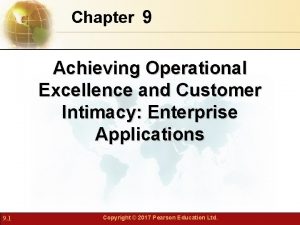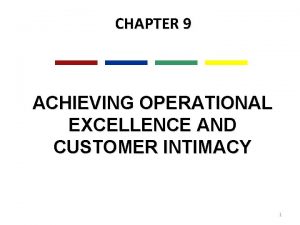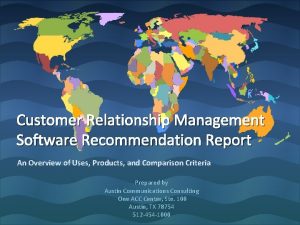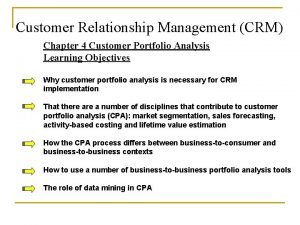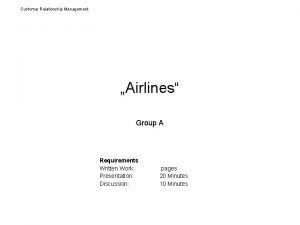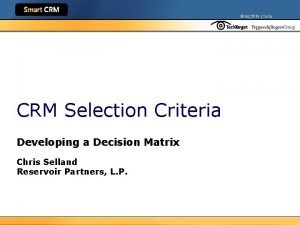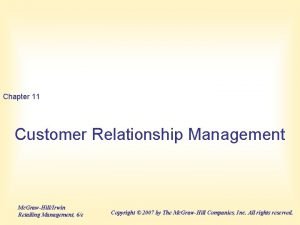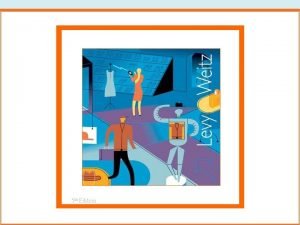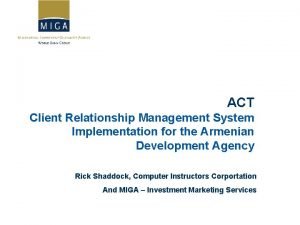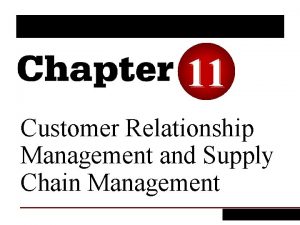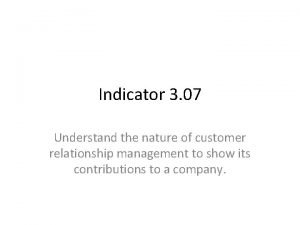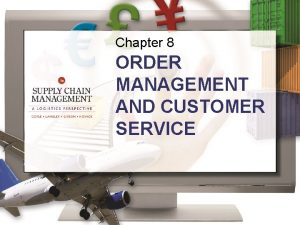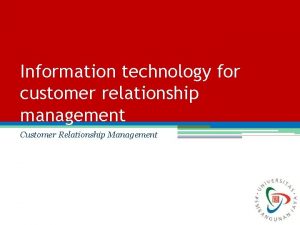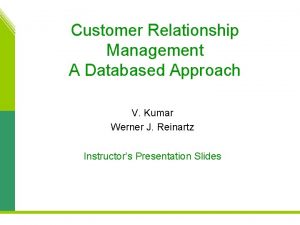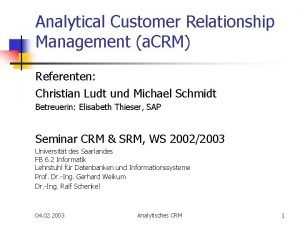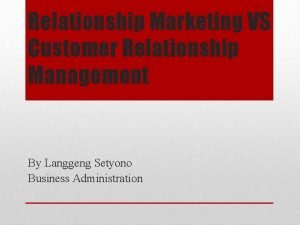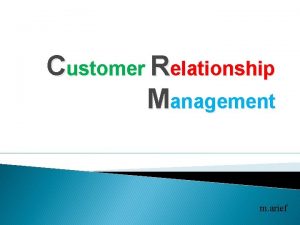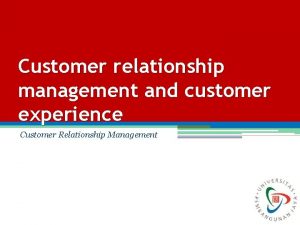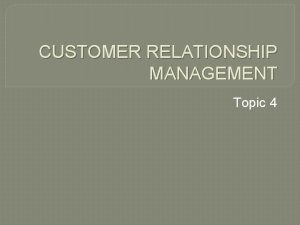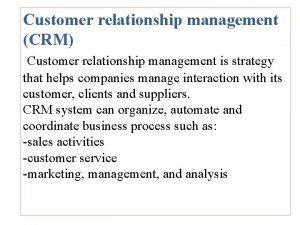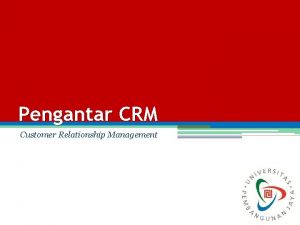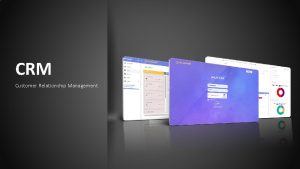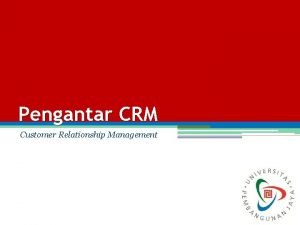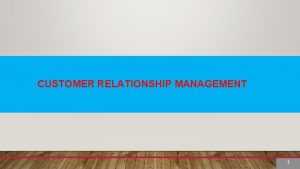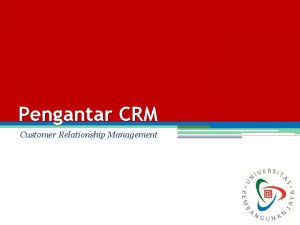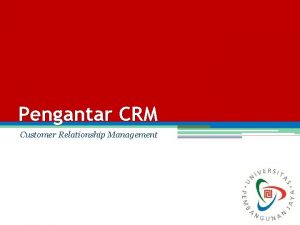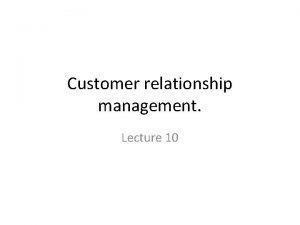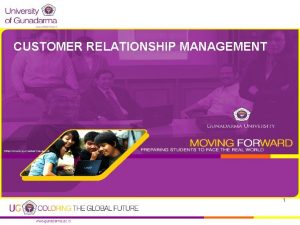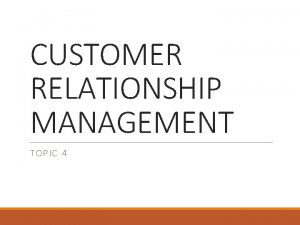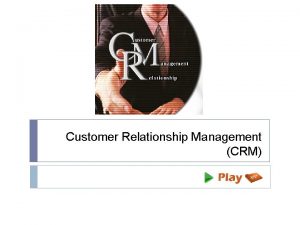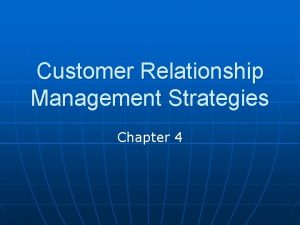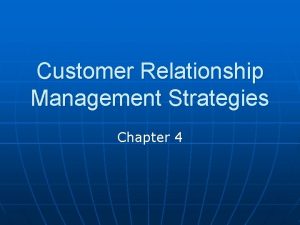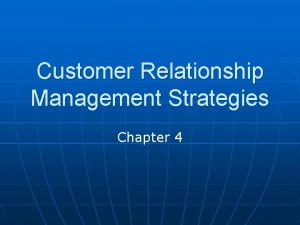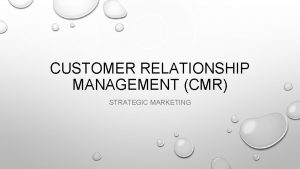CHAPTER 11 2 1 Customer Relationship Management CHAPTER






















- Slides: 22

CHAPTER 11 2 1 Customer Relationship Management CHAPTER 11 Mc. Graw-Hill/Irwin Retailing Management 8 e Copyright © 2012 by The Mc. Graw-Hill Companies, Inc. All rights reserved. © The Mc. Graw-Hill Companies, All rights reserved. 11 -

Customer Relationship Management (CRM) CHAPTER 11 2 1 • A business philosophy and set of strategies, programs, and systems that focus on identifying and building loyalty with a retailer’s most valuable customers. • All customers are not equally profitable, and more or less profitable customers need to be treated differently • Retailers now concentrate on providing more value to their best customers using targeted promotions and services to increase their share of wallet – the percentage of the customers’ purchases made from the retailer 11 -

Customer Loyalty CHAPTER 11 2 1 • Committed to purchasing merchandise and services from a retailer • Resist efforts of competitors to attract the loyal customer • Emotional attachment to retailer • Personal attention • Memorable positive experiences • Brand building communications programs 11 -

Can Offering Price Discounts Achieve Customer Loyalty? CHAPTER 11 2 1 No! Retail strategies like these can be copied by competitors These strategies encourage customers to be always looking for the best deal rather than developing a relationship with a retailer Mc. Graw-Hill Companies, Inc. /Gary He, photographer 11 -

The CRM Process CHAPTER 11 2 1 CRM is an iterative process that turns customer data into customer loyalty through four activities: 1. Collecting customer data 2. Analyzing the customer data and identifying target customers 3. Developing CRM programs 4. Implementing CRM programs 11 -

CRM Process Cycle CHAPTER 11 2 1 11 -

Collecting Customer Data: Customer Database CHAPTER 11 2 1 • Transactions – a complete history of purchases • Purchase date, price paid, SKUs bought, whether or not the purchase was stimulated by a promotion • Customer contacts by retailer (touch points) --visits to web site, inquires to call center, direct mail sent to customer • Customer preferences • Descriptive information about customer • Demographic and psychographic data • Customer’s responses to marketing activities 11 -

Collecting Customer Data: Identifying Information CHAPTER 11 2 1 Approaches that store-based retailers use: • Asking for identifying information • Telephone number, name and address • Offering frequent shopper cards • Loyalty programs that identify and provide rewards to customers who patronize a retailer • Private label credit card (that has the store’s name on it) • Connecting Internet purchasing data with the stores 11 -

Heighten Privacy Concerns When Using Electronic Channel CHAPTER 11 2 1 • Information collected without the awareness of customers • Collecting click stream data using cookies Similar to an invisible person videotaping a customer as they walk through a store Stockbyte/Punchstock Images 11 -

Customer’s Decision to Offer Information CHAPTER 11 2 1 11 -

Protecting Customer Privacy: Differences between U. S. and EU United States • Limited protection in specific areas • • Credit reporting Video rentals Banking Medical records • Opt out: Consumers must explicitly tell retailers not to use their personal information CHAPTER 11 2 1 European Union • Stringent consumer privacy laws • Information only can be collected for specific purposes • Purpose must be disclosed to customer • Information can only be used for specific purpose • Information cannot be exported to countries with less stringent regulations • Opt in: Consumers own their personal information, and retailers must get consumers to explicitly agree to share this personal information 11 -

Market Basket Analysis CHAPTER 11 2 1 Data analysis focusing upon the composition of the customer’s market basket – what items are bought during a single shopping occasion Uses: • Adjacencies for displaying merchandise • Joint promotions • Bananas in the cereal aisle as well as in the produce section • Beer with baby dippers • Tissues with cold medicine Burke/Triolo Productions/Getty Images 11 -

Market Basket Analysis Taught Wal-Mart to Change! Product Bananas Kleenex CHAPTER 11 2 1 Placed Near cornflakes, produce paper goods, cold medicine Measuring spoons housewares, Crisco shortening Flashlights hardware, Halloween costumes Little Debbie snack cakes Bug spray coffee hunting gear 11 -

Identifying Best Customers CHAPTER 11 2 1 • Estimating Lifetime Value (LTV) • The expected contribution from the customer to the retailer’s profits over his or her entire relationship with the retailer • Use past behaviors to forecast future purchases, the gross margin from these purchases, and the costs associated with serving the customers • Classifying Customers by recency, frequency, and monetary value of purchases (RFM Analysis) (c) Brand X Pictures/Punch. Stock 11 -

Which Customer Probably Has the Greatest Lifetime Value CHAPTER 11 2 1 Purchases Over Last 10 Weeks 11 -

Customer Pyramid CHAPTER 11 2 1 Platinum Best Most loyal Least price sensitive 80 -20 rule: 80% of sales or profits come from 20% of the customers 11 -

Customer Retention CHAPTER 11 2 1 • Frequent Shopper Programs • Special Customer Services • Personalization • 1 -to 1 Retailing • Community Royalty-Free/CORBIS 11 -

Elements in Effective Frequent Shopper Programs CHAPTER 11 2 1 • Tiered rewards based on customer value • Offer choices of rewards • No all customers value the same rewards • Non-monetary incentives, altruistic rewards • Reward all transactions to ensure the collection of all customer transaction data and encourage repeat purchases • Transparent and simple so that customers easily understand when they will receive rewards 11 -

Personalization CHAPTER 11 2 1 11 -

Dealing with Unprofitable Customers CHAPTER 11 2 1 • Offer less costly approaches for dealing with these customers • Charge customers for extra services demanded Don Farrall/Getty Images 11 -

Implementing CRM Programs CHAPTER 11 2 1 • More than CRM management, computer systems, and communication about the importance of customers. • In addition…. . • Close coordination between departments – Marketing, MIS, Operations, HR • Shift in orientation • Product Centric • Customer Centric 11 -

Keywords CHAPTER 11 2 1 • RFM (recency, frequency, monetary) analysis Often used by catalog retailers and direct marketers, a scheme for segmenting customers on the basis of how recently they have made a purchase, how frequently they make purchases, and how much they have bought. • frequent-shopper program A reward and communication program used by a retailer to encourage continued purchases from the retailer’s best customers. • 1 -to-1 retailing Developing retail programs for 11 -
 Customer relationship management and customer intimacy
Customer relationship management and customer intimacy Customer relationship management and customer intimacy
Customer relationship management and customer intimacy Intimacy
Intimacy Functional components of e-crm
Functional components of e-crm Software recommendation report
Software recommendation report Customer relationship management training ppt
Customer relationship management training ppt Customer portfolio management
Customer portfolio management Airline customer relationship management
Airline customer relationship management Crm selection process
Crm selection process Effective frequent-shopper programs are transparent.
Effective frequent-shopper programs are transparent. Crm in marketing ppt
Crm in marketing ppt Act customer relationship management
Act customer relationship management Customer relationship management in supply chain
Customer relationship management in supply chain Nature of customer relationship management
Nature of customer relationship management Order management & customer service relationship concept
Order management & customer service relationship concept Cayenta work management system
Cayenta work management system Information technology and customer relationship management
Information technology and customer relationship management Rfm
Rfm Kundenlebenszyklus 6 phasen
Kundenlebenszyklus 6 phasen Crmsugar
Crmsugar Relationship management vs relationship marketing
Relationship management vs relationship marketing Managing marketing information
Managing marketing information Pengertian customer relationship
Pengertian customer relationship

